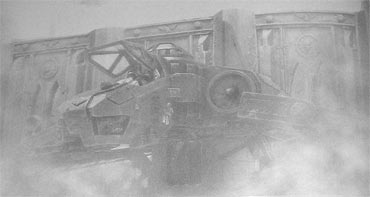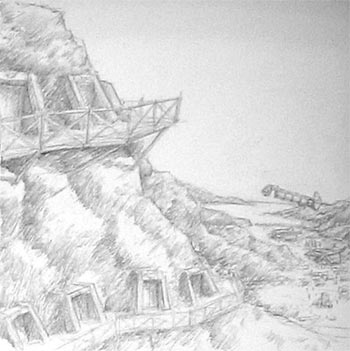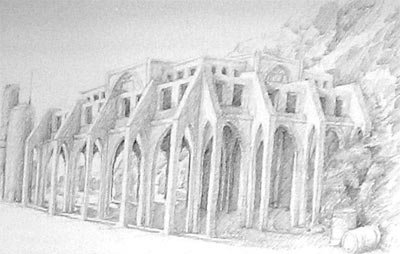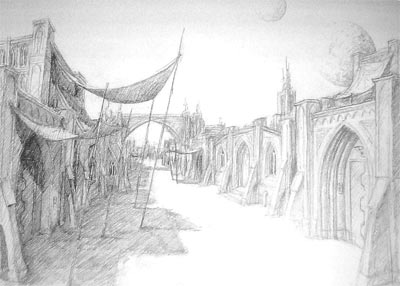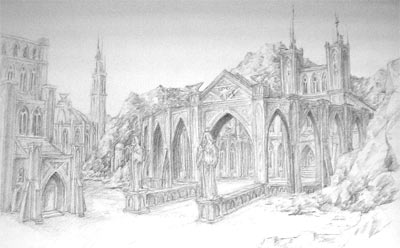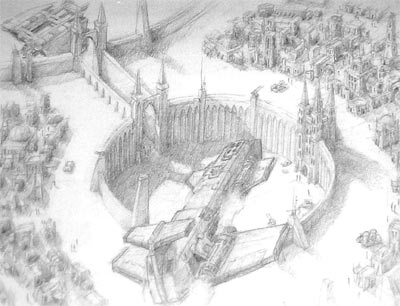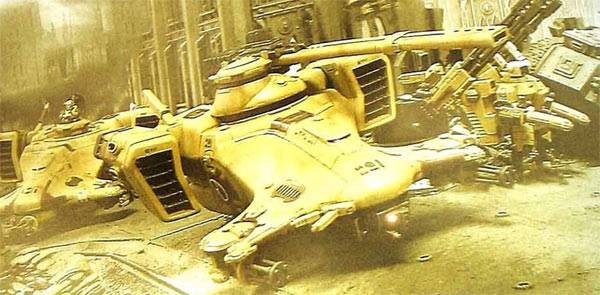
Таu military forces move through the streets of Tarokeen, as the aliens occupy the city in the name of the Таu Empire.
THE ROAD TO WAR
CHAPTER 1
The Imperium of Man is vast, consisting of over a million worlds scattered the length and breadth of the galaxy. It is the greatest empire in human history, and as a great empire the casual observer might think that the Imperium is strong - strong enough to resist and defeat any threat - but it is not so. In truth, the Imperium is failing The galaxy is a dark and terrible place, filled with bloodthirsty aliens, malign powers and horrors too terrible to name. Beset by external wars and internal divisions the Imperium of Man must constantly fight for survival. The continued maintenance and protection of the Imperium is governed by the Adeptus Administratum, a vast and labyrinthine bureaucracy centred on Terra, from which every segmentum, sector, sub-sector and solar system is run. The task is vast and complex, so complex that the Administratum cannot control every aspect of it. Within the Administratum sub-organisations have their own areas of responsibility. One of the largest of their organisations is the Department Munitorum, which oversees the supply of men and material to the Imperium's largest armed force, the Imperial Guard. In itself this is a task of epic proportions. The Imperial Guard is a fighting force consisting of billions of men and millions of fighting vehicles. It is deployed to warzones and garrisons across the galaxy. At any one time the Imperial Guard might be engaged in thousands, maybe tens of thousands of conflicts, all of which need supplying. As the Department Munitorum labours to meet these demands, the threat to the Imperium's continued existence is growing. As the end of the forty-first millennium grew closer, the omens of a new and terrible threat to tne Imperium began to grow. Within the Eye of Terror, where warp-space and real-space overlap and the worshippers of the Chaos gods rule, the Warmaster of Chaos. Abaddon, the Arch-Traitor, Destroyer of Worlds, was making his plans and gathering his strength for a new assault upon the Imperium and its false Emperor. Driven by the bloody desires of his insane gods and a thirst for vengeance which had not been quenched by ten thousand years of war, Abaddon's 13th Black Crusade was mustering its forces, secure within the Eye of Terror. When Abaddon's storm broke it would be the largest Black Crusade yet. Abaddon would unleash his diabolic forces from within the Eye with the objective of capturing the Cadian Gate. The Cadian Gate is the only stable passage from the Eye of Terror, and the most direct route between the Eye and the centre of the Imperium, Holy Terra. Abaddon's ultimate objective, like that of Horus, his master before him, is the overthrowing of the Emperor's rule and the destruction of the Imperium. To do this he must eventually assault Terra. The capture of the Cadian Gate would be a large step towards that ultimate objective. But the Cadian Gate is a lynchpin in the strategic defence of Holy Terra. Cadia is a bastion world, the most militaristic in the Imperium; a hugely strong fortress-world protected by fleets of the Imperial Navy, orbited by powerful battle stations, and defended by the strongest bastions, garrisoned by regiments of hardy Cadian Shock Troops. The surrounding worlds are also well protected and garrisoned. The capture of the Cadian Gate would require a huge assault, and plunge the Imperium into its largest single war since trie arrival of Hive Fleet Kraken on the distant Eastern Fringe. When Abaddon's Crusade struck it would be a war that required the full weight of the Imperium's resources to win. It would be a battle of titanic proportions. War on such a massive scale does not come secretly or by surprise. The Imperium is not completely blind to events within the Eye of Terror. Sages and seers were forecasting dire warnings long before Abaddon launched his crusade Omens taken from the Emperor's Tarot predicted the threat. Raids were increasing around the Eye of Terror. The Adeptus Mechanicus Exploritas launched nullships deep into the Eye of Terror, to send back information about events inside. What they found sent shock waves through the upper echelons of the Imperium. The twelve High Lords of Terra, the council that rules the Imperium in the Emperor's place, long debated what course of action to take. It was clear that the defences must be strengthened, reserves must be found, weapons, ammunition and supplies stockpiled on armoury worlds across Segmentum Obscurus, Space Marine Chapters must be readied and positioned to respond to the attack. Wherever the hammer-blow fell the Imperial Guard must first hold, and then drive back, the followers of Chaos. Every fighting force at the Imperium's disposable must be ready to fight to the last shell and last man to protect the Cadian Gate. If the High Lords of Terra decree it, then so it shall be, for they speak with the authority of the Emperor. Their word is law. The Administratum set about the task of preparing the Imperium for another great war. Abaddon's 13th Black Crusade would indirectly affect every part of the Imperium, whether it was demands for new Imperial Guard regiments, increased tithes or higher production from the forge worlds to meet supply demands. Abaddon's ambition could be likened to throwing a stone into a pond, where the ripples stretched out to the far corners of the galaxy. In Ultima Segmentum, the largest of the five great Segmentums that divide the Imperium, the effects would also be felt, even as far away as the Eastern Fringe. Stygies VIII is one of Ultima Segmentum's greatest forge worlds, and one the Adeptus Mechanicus' largest research and production facilities. In productivity Stygie VIII stands in the second tier of forge worlds, with Mars alone on the top tier. Situated in the Vulcanis system and covering the entire surface of the eighth moon of the ringed gas-gaint Stygies, the forge world is one of the most productive in Ultima Segmentum, and of great importance to the Imperium's war efforts. As a forge world, Stygies VIII does not pay tithes to the Administratum, instead it is bound to supply arms, munitions and equipment to the Departmento Munitorum for use by the Imperial Guard. This is a very important task, productivity is carefully monitored to meet demand forecasts (itself something of arcane art practiced by the Adeptus Mechanicus' Logis). Should the forge world fall behind it might have serious consequences in the future when, in some far-off warzone, the ammunition or replacement weapons begins to run out. The Departmento Munitorum spends a lot of its time and resources making sure this does not happen. Carrying the authority of the Master of the Administratum, Departmento Munitorum official arrived on Stygies VIII with a new set of production figures and targets The forecasts of a coming Black Crusade meant many new Imperial Guard regiments were being raised, and these fighting men needed equipping. The rulers of Stygies VIII and a High-Prefect of the Departmento Munitorum held long councils to discuss the new requirements. At this council Stygies VIII argued that if production was to be increased, then more refined and raw materials would need to be found. The lifeblood of any forge world is the material it consumes. For production on the scale of Stygies VIII, vast amounts of minerals and chemicals are required. Mining planets across the Imperium supplies these demands. The task of finding new matenals was a big one. and the Departmento officials returned to Terra to begin it. Administratum Auditors set about finding where reserves had been located and catalogued, and where planetary-audits suggested that extra productivity might be squeezed from refineries. It was during this process of evaluation and cross-referencing that the planet of Taros first came to Administratum bureaucrats attention. Taros was a small mining planet deep in Ultima Segmentum. It was unremarkable except for two things: the estimated size of the planet's untapped mineral wealth and secondly, its rather too-close-for-comfort proximity to the expanding borders of the alien Таu Empire. The Departmento Munitorum briefed a delegation to visit this backwater planet. Armed with an ancient audit report compiled in the 38th millennium by officials collecting data tor just such circumstances. Auditor-Prime Nymus Dree and his team of scribes and archivists were dispatched to inform the Planetary Governor of Taros of his new increased production targets and to help organise how the targets could best be met. Dree was authorised to use the Department's ultimate sanction. Under the conditions of the Pax Imperialis, if the Planetary Governor could not. or would not, meet the increased targets, then he would be replaced by a new Governor, one who could. The man chosen to lead the delegation to Taros was Auditor-Prime Nymus Dree, a functionary from the upper ranks of the Departmento Munitorum. He was accompanied by a team of record-scribes and messenger-cyphers. On leaving Terra his first port of call was Stygies VIII, to collect representatives from that forge world, including a High Magos Metallurgicus, an expert in the study of metals. Dree also needed to confirm his own figures and calculations with the needs of the forge world, before moving on to Taros. Given the location of Taros, an Imperial Navy escort was requested, and granted, for the delegation's transport ship. The first Taros' rulers knew about the delegation from Terra and Stygies VIII was when a transport and two Imperial Navy frigates unexpectedly arrived in system. This was a deliberate policy by Dree, not to forewarn the Planetary Governor, and thus give the delegation the best chance of seeing how efficiently the mining operation was currently being run. After a long and arduous warp journey the three ships safely entered orbit around Taros. Drees delegation boarded a flight of Aquila shuttles and transferred down to the space port at Taros City (Tarokeen), the planet's only city. The Planetary Governor, with his advisors and officials awaited the delegation's arrival and greeted them with due ceremony. The entire entourage transferred to the Governor's Palace, where an official meeting was scheduled for Dree to inform the Planetary Governor of the Administratum's revised plans. After the meeting Dree began a tour of the mining works to see for himself how the operations were conducted and interview the mineowners in person. Meanwhile the Adeptus Mechanicus representatives would begin assess the quality and purity of the ore currently being supplied from Taros. Planetary Governor, Lord Aulis, accepted that with the Munitorum's aid, that current productivity levels could be increased, and that the new targets required to keep Stygies VIII forge world operating at its increased capacity were achievable. He promised to do all in his power to meet the targets, and in all respects was the loyal and convivial host to the Imperium's officials. To begin with he aroused no suspicion within the delegation. It was not until Auditor-Prime Dree started to visit the outlying mining sites that he started to wonder about certain aspects of the mining operation on Taros. Firstly, there were many abandoned mining sites scarring the deserts, evidence of much activity. Each time he was told that the lode or ore seam had been mined out, and the operation had moved on. To the mine owners this was evidence of industrious hard work, but to an Auditor it was the physical evidence that the planet's estimated reserves where being eaten into, or were not as large as had been originally claimed in the M38, audit. Dree's tour continued, and each mining operation seemed to be working hard, finding new lodes and blasting them out in huge strip mining operations. The ore was being separated and shipped in large quantities to the space port at Tarokeen. The stockpiles at Tarokeen were now large, awaiting the arrival of empty transports to carry it away to refineries. On the surface all was well, but Auditor Dree started to look deeper. Each mine was requested to hand over productivity statements, going back for ten or twenty years. Several mineowners could not, their records were incomplete, but most responded and from them Dree began to get an overall picture of how much ore had recently been exported off Taros. Next he looked into survey and geological reports about new lodes and the size of these finds. From this information he gained a good idea of how much mineral wealth remained. These figures did not tally with how much the ancient audit report claimed. At the current rates of extraction, using figures collected from refineries and Stygies VIII, there should have been more left than current estimates stated. There was a disparity between the different sources figures, which concerned Dree. Had Taros been over-mining, in which case where where the stockpiles? Those in storage in Tarokeen did not cover the disparity. Or had Stygies VIII got it wrong, in which case the forecast figures might also be mistaken, and the far-reaching effects of this could result in a future lack of supplies. For now the Auditor kept his suspicions to himself. It took Dree several weeks to gather all the information he needed from Taros. By the end of his investigation he had a good idea of what had been happening here. The mines had been over-producing. For years they had been stripping out ore at a greater rate than was required or needed. All this ore had been shipped to Tarokeen, and although quotas for refineries and Stygies Vlll itself had been met, the rest of the valuable ores had vanished. Because there was no let up in the supply the mistake had never been noticed. The book-keeping trail ended here. Where had the missing ore gone? Before leaving Taros, Dree decided to confront the Planetary Governor about the disparity and seek an explanation, although it was likely that the Governor himself had no idea about the problem. Governor Aulis did indeed claim ignorance. As far as he was concerned quotas had been met, and shipments had been made on time. He didn't concern himself with the day-to-day running of mines, that was the job of the owners. Governor Aulis' advice was to 'ask them!'. So Dree did just that, requesting that the largest mineowners each attend a hearing to explain the figures. They had no explanation. They just dug and blasted, and dug some more. They found lodes and stripped them out as fast as they could with the workforce available to them. Ignorance was their defence. Getting nowhere, and suspecting a conspiracy of silence, Dree decided more drastic action was needed. Unknown to Auditor Prime Dree he was starting to scratch the surface of events which had been developing over the past two decades on Taros. The arrival of his delegation had, to the casual observer, been gracefully received. In fact, his presence had caused wide-spread concern throughout ruling elite of Taros.
The Tau had a long time interest in the planet of Taros. As their Empire had expanded, systems had been systematically scouted for possible colonisation. Many had been identified. One such planet was Taros. It had a breathable atmosphere, and although it was a harsh desert planet (the Tau themselves are better adapted to hot climates than cold) it has some water and was capable of sustaining life. Best of all, it had abundant mineral wealth. It was noted as a good prospect for future expansion and swift colonisation, but there was one major drawback. Taros was the Imperium's world, and that meant capturing it would be difficult. Since first contact with the Imperium at Devlan, when a scout ship had been destroyed, the Tau had learned that the Imperium would not easily give up worlds claimed in their Emperor's name. Any military attack would bring a swift response. Capturing Taros would involve a major war, and the Ethereals on T'au did not believe the gains outweighed the risks. For now there were other, easier, targets. Any initial plans for a quick invasion were shelved, but Taros was not forgotten. Instead of calling upon the Fire Caste to capture Taros, the council first turned to the Water Caste. Diplomatic moves might bring results if the Water Caste played a quiet, patient game. The Imperium's worlds usually refused all contact with aliens, and the Water Caste had learnt that many Planetary Governors could not be seen to be in negotiations with aliens, for fear of their own rulers finding out. However deals and small trading could be negotiated if everything was kept secret. Merchant guildmasters and the leaders of trading cartels were rich, greedy men, and a chance to trade with the dynamic Tau Empire offered them riches they could not find anywhere else on the Eastern Fringe. A delegation of the most experienced and cunning Water Caste diplomats was sent to Taros to seek a meeting with its rulers. This team included human representatives from other worlds already working with the Tau. Armed with assurances that the Tau Empire had no ambitions to continual expand in this area, and that Taros was completely safe from attack the diplomats were only to seek small trading contracts In return for very small amounts of manganese ore, the Tau could offer water purification and recycling technology, as well as hydroponics equipment for growing food and luxury goods. These items could make a harsh life on Taros that much easier for its social elite. At first, the Planetary Governor baulked at the Water Castes approaches. He knew full well that trading with aliens was strictly forbidden, but Taros was just one planet in a million and small amounts of ore would not be missed. Governor Aulis talked to the mineowners and merchants, and in turn they saw a chance to make extra money and wealth. The Imperium's quotas had not been changed in generations. The mining operations were working efficiently. The Administratum was content. Who would know or care if some extra manganese or vanadium ore was blasted out and sold to these Tau? Other human worlds had grown rich doing it, the alien delegates had brought the proof with them and, in the long run good relations might help keep Tau expansionism at bay. Negotiations were completed some twenty years ago, and the Tau got their first foot in the door on Taros. The agreement started very small, no more than one shipment of manganese and vanadium a year, but gradually, as the Planetary Governor and his mineowners got away with it, the amounts being shipped increased. The tithes set by the Administratum were still being met, but the mines began to find extra new lodes to exploit. Over the next ten years, the Tau gained more and more say in the mining operations, several Earth Caste delegations visited to offer aid and advice. The Tau paid for the ore in technology and luxury goods such as precious stones from Tash'varr and exotic fruits from Au'taal. The high society of Taros began to grow wealthy on the illicit trade. For almost two decades the Administratum's bureaucrats remained ignorant, whilst the Tau's influence grew. The unexpected arrival of the Adeptus Munitorum delegation caused much concern in the inner circle of Taros' ruling elite. Those mineowners who were profiting by the deal became very nervous. Governor Aulis urged calm. He argued that they could bluff it out, claim ignorance, lie, cover-up, anything. He believed the delegation would do its duty, the increased tithes could still be met, and nothing need ever be found out. Act too hastily and the conspiracy would be uncovered, and they would all be arrested. However, the Planetary Governor did not reckon on the thoroughness of Auditor Prime Dree. Soon, cracks in the cover-up and lies were being found and suspicions aroused. As Dree dug deeper concern grew. For the conspirators, the situation was becoming desperate. Some mineowners even advocated assassinating the entire delegation and blaming the Tau. The Planetary Governor forbade it. If the delegation were harmed it would only be worse for them all in the long term. Maybe he could find some way of discrediting Auditor Dree's report. Lord Aulis continued to try and bluff it out until the delegation left. Unknown to him events far away, and beyond his control in the Denab system would reveal all... Meanwhile, unrelated to any events around the Eye of Terror or Taros, the Imperial Navy's Patrol Group Ravanor was conducting a routine anti-pirate sweep through the Denab system, an area of wilderness space on the edge of the Damocles Gulf. The five-ship patrol, operating under standing orders to attack and seize suspected pirate vessels or conduct harrying raids against Tau targets of opportunity, was under the command of Captain Darillian of the Dauntless light cruiser Lord Ravanor. The patrol had been out for several months with little success, and Captain Darillian was preparing to return to base and report that pirate activity in the area was minimal when the Sword class frigate Patrol Group Ravanor carefully stalked the three vessels through the Denab asteroid belt, maintaining a distance that would not reveal their presence and making maximum use of the asteroid belt's cover. For three days they maintained the stand-off pursuit, hoping the three vessels would lead them to a pirate base or a rendezvous point, and a far greater prize. It seemed Captain Darillian was correct. The convoy was making for a small deep-space facility on the edge of the Denab belt. As the ships approached it was revealed to be no pirate base. Instead, scanner readings from his leading ship revealed the presence of a Tau waystation. Captain Darillian had experience operating around the Damocles Gulf and had encountered such facilities before, scattered in remote locations. Why would three transport freighters be rendezvousing with an alien waystation? Positioning a single escort vessel to maintain the surveillance, the Captain withdrew and reported the curious events to fleet command.
Whilst the Lord Ravanor was away, the frigate VCS-6 observed the three transports dock at the way station and a single Tau vessel, of the 'Emissary' class, left shortly afterwards. Hidden within the asteroid belt, VCS-6 watched and waited. Meanwhile, Captain Darillian's astropathic message reached Imperial Navy High Command who were equally in the dark about these events. Inquiries about these three ships revealed nothing. Whoever these ships belonged to, they were obviously consorting with aliens. New orders were issued to Patrol Group Ravanor - destroy the Tau waystation and capture the transports. Prisoners were to be taken for further interrogation. The Lord Ravanor returned to rendezvous with VCS-6 and prepared to attack. The crews were roused to battle-stations and the escort captains briefed. The group would slowly approach the station through the asteroid belt and then attack at all ahead full, giving the rogue transports the minimum of time to effect an escape. The Lord Ravanor would engage the waystation, whilst the escorts prevented any escape or pursued any transports that tried to flee. After crippling the waystation the Lord Ravanor would then grapple alongside a transport and board her to take her as a prize and capture the crew. Captain Darillian issued his final order "On my command, go straight at them. All ahead full, no mercy, and may the Emperor rot their treacherous hearts!" With that order the great plasma reactors of the five Imperial Navy ships roared into life, accelerating them out of the asteroid belt in line astern, and directly at the waystation. With surprise on their side, the patrol group raced past the waystation, unleashing a full broadside at short range. Lance batteries and macro-cannons roared into the void, impacting upon the waystation with shuddering explosions. The station attempted to return fire as best she could, with little effect. One transport was immediately hit and crippled as it lay at berth, the others, as predicted, attempted to disengage and flee. Scadryn squadron was immediately in rapid pursuit. It seemed his surprise attack had worked, except, Captain Darillian was about the get a surprise himself. His bridge survey-controllers urgently reported more Tau vessels approaching. A second convoy of transports and an escort of light warships, identified as of the Castellan class, had appeared on scanner screens. The Tau were closing fast. Suddenly, from a one-sided ambush, Patrol Group Ravanor had a real fight on its hands. Reacting to the new situation the Captain recalled his escorts from their pursuit and set a new course to intercept the approaching Tau vessels. "Helm, lay us alongside at spirting distance. We'll match shot with these dogs, and I'll wager we outmatch them." The gruff old Captain ordered a new attack, calculating that he had enough firepower to see the Tau convoy off or destroy it entirely. With her four escorts closing in behind her, the Lord Ravanor ploughed in amongst the alien convoy, broadsides blazing from both starboard and port batteries. In return, the Tau vessels peppered her back, shields flaring and decks quaking under the impacts of railguns and ion cannons. It was bitter and hard fought at close range, with both sides inflicting heavy damage during the engagement. The Sword class frigates VCS-6 and 7 were both crippled, and the Lord Ravanor was limping with engine damage and fires on several decks. But the Tau convoy was scattered, leaving one drifting transport as a wreck and both Castellans, the targets of the Lord Ravanor's heaviest guns, as burning hulks. To the cheers of her gun crews Patrol Group Ravanor had had the best of it and decisively won the skirmish. In the process two of the rogue transports had escaped. Captain Darillian gathered his battered but victorious officers and issued orders for the post-battle operations. Boarding parties were to be readied to board the waystation and crippled transport. All prisoners were to be brought directly to him. A second party was to board the Tau transport and seize her cargo. Meanwhile, VCS-8 and 9 were to rescue surviving crew from the patrol group's two crippled escorts. After completion of operations they would make course out of the Denab system and home, battle-scarred but victorious. Aboard the Tau transport the boarding party found only empty holds. The waystation had been badly damaged, and a final bombardment before departing would destroy it beyond salvage. Crewmen from the crippled rogue transport were captured after a brief skirmish with survivors. It seemed they had no knowledge of the ship's cargo, but the ship's log recorded that their last port of call had been Taros. The crewmen claimed not to know why they were here, or why their cargo was being unloaded by the Tau. They were just following orders, but orders from whom? The prisoners would be turned over to Inquisitorial interrogators once the Lord Ravanor returned to port, and then lying tongues would loosen.
On his return, Captain Darillian was awarded the Order of the Knights of Damocles and promoted to Captain the cruiser Hammer of Thrace for his part in winning the engagement. He filed a full report about the 'Denab Incident', but the truth behind the events remained a mystery to the Imperial Navy. The truth remained a mystery only until the Denab Incident report was discovered by Auditor Prime Dree, during his research into the missing minerals on Taros. For Dree, Patrol Group Ravanor's discovery was evidence of treachery. Dree's suspicions were confirmed. The three transports had been carrying a cargo of manganese, vanadium and rhenium ore, loaded at Taros and originally destined for refineries which in turn supplied Stygies VIII. But the convoy had been diverted and then ordered to unload some of their cargo at the Tau waystation, from where it would be transferred to Tau vessels and transported back into the Tau Empire for their own use. This would not have been the first time valuable resources had been given, or more likely sold, to the aliens. The patrol group's luck in stumbling across the convoy and waystation had given the Departmento Munitorum official the damning evidence he needed. There was a conspiracy on Taros, a secret deal with the Tau Empire to syphon-off mineral resources, which belonged to the Imperium. Dree was sure that the Planetary Governor must be at the heart of the conspiracy. Lord Aulis might be all industrious loyalty on the outside, but within beat the black heart of traitor to the Imperium. The Planetary Governor had broken the sacred Pax Imperialis, and swift retribution would be his reward. Auditor Prime Dree presented his report to the Office of the Master of the Adeptus Munitorum on Terra, for consideration of action to be taken. Dree had completed the investigation but it was now out of his hands. He had no power to decide what to do about Taros, only to present his findings. Only an Inquisitor would have the sweeping powers to intervene, and Dree was a mere bureaucrat. The Office of the Master of the Adeptus Munitorum on Terra is in itself vast, overseeing much of the work of the Departmento's many sub-departments. It would take several months for the bureaucracy to process Dree's report and for anybody with real authority to eventually see it. His report was just one amongst thousands. Dree returned to his day-to-day functions. The wheels of the Administratum's bureaucracy do not turn fast, but slowly events on Taros came to the attention of the Master of the Adeptus Munitorum's office. A report claiming serious breaches of the Pax Imperialis and conspiring with aliens was to be taken seriously. Dree was summoned to a hearing to explain his findings, which he did. Things on Taros were rotten, Dree said, and the Planetary Governor was at the heart of the conspiracy. Action needed to be taken, swift action to end the problem. Amongst the upper ranks of the Adeptus Terra it was decided that the Planetary Governor should be removed and replaced with a more trustworthy candidate. The Administratum started to consider its options. The first and most obvious option was to contact the Officio Assassinorum and secretly dispatch one of the Imperium's most lethal weapons to Taros. Maybe a servant of the Vindicare temple to execute the Governor for his crime with a single well placed sniper shot to the head, or a servant of the Callidus temple could infiltrate his organisation and get close enough for a silent knife in the dark. But the simple death of the Planetary Governor would not solve the problem. Taros was close to the Tau Empire, and an obvious prospect for Tau expansionist ambitions. The Imperium needed to send the aliens a strong message - that Tau interference on Taros would not be tolerated. The problem was not just the Planetary Governor, it was also the Tau. Simply assassinating Lord Aulis would not deter their ambitions. The Officio Assassinorum was ruled out in favour of a bolder, larger plan - a coup d'etat. A strike force would target the Planetary Governor and his supporters. Using maximum force they would demonstrate to Tau observers the Emperor's will to hold onto Taros. Once the operation was complete, the strike force would become a temporary garrison to deter any Tau counter-attacks. There was one force capable of such a mission at short notice, the Adeptus Astartes. The Space Marines would be the Emperor's instrument of divine justice on Taros. During the Damocles Gulf Campaign the Tau had learned to fear Mankind's finest warriors, and a strike force on the ground would send an unmistakable message - the Imperium will do everything it can to hold Taros. If the Tau wanted the planet they must first face the Space Marines! A Space Marine Chapter was quickly identified for the coup d'etat mission and a high-level delegation with the relevant intelligence information was immediately dispatched to the Chapter-Monastery of the Avenging Sons, along with a well worded request signed by the Master of the Administratum's office asking the Chapter Master for his assistance. Official records would later name this operation 'the First Taros Intervention'.
|
